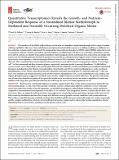Quantitative Transcriptomics Reveals the Growth- and Nutrient-Dependent Response of a Streamlined Marine Methylotroph to Methanol and Naturally Occurring Dissolved Organic Matter
Author(s)
Repeta, Daniel J.; Becker, Jamie William; Sosa, Oscar Abraham; DeLong, Edward Francis; Gifford, Scott M.
DownloadGifford-2016-Quantitative Transcriptomics Reve.pdf (2.450Mb)
PUBLISHER_CC
Publisher with Creative Commons License
Creative Commons Attribution
Terms of use
Metadata
Show full item recordAbstract
The members of the OM43 clade of Betaproteobacteria are abundant coastal methylotrophs with a range of carbon-utilizing capabilities. However, their underlying transcriptional and metabolic responses to shifting conditions or different carbon substrates remain poorly understood. We examined the transcriptional dynamics of OM43 isolate NB0046 subjected to various inorganic nutrient, vitamin, and carbon substrate regimes over different growth phases to (i) develop a quantitative model of its mRNA content; (ii) identify transcriptional markers of physiological activity, nutritional state, and carbon and energy utilization; and (iii) identify pathways involved in methanol or naturally occurring dissolved organic matter (DOM) metabolism. Quantitative transcriptomics, achieved through addition of internal RNA standards, allowed for analyses on a transcripts-per-cell scale. This streamlined bacterium exhibited substantial shifts in total mRNA content (ranging from 1,800 to 17 transcripts cell[superscript −1] in the exponential and deep stationary phases, respectively) and gene-specific transcript abundances (>1,000-fold increases in some cases), depending on the growth phase and nutrient conditions. Carbon metabolism genes exhibited substantial dynamics, including those for ribulose monophosphate, tricarboxylic acid (TCA), and proteorhodopsin, as well as methanol dehydrogenase (xoxF), which, while always the most abundant transcript, increased from 5 to 120 transcripts cell[superscript −1] when cultures were nutrient and vitamin amended. In the DOM treatment, upregulation of TCA cycle, methylcitrate cycle, vitamin, and organic phosphorus genes suggested a metabolic route for this complex mixture of carbon substrates. The genome-wide inventory of transcript abundances produced here provides insight into a streamlined marine bacterium’s regulation of carbon metabolism and energy flow, providing benchmarks for evaluating the activity of OM43 populations in situ.
Date issued
2016-11Department
Massachusetts Institute of Technology. Department of Civil and Environmental EngineeringJournal
mBio
Publisher
American Society for Microbiology
Citation
Gifford, Scott M. et al. “Quantitative Transcriptomics Reveals the Growth- and Nutrient-Dependent Response of a Streamlined Marine Methylotroph to Methanol and Naturally Occurring Dissolved Organic Matter.” mBio 7.6 (2016): e01279-16.
Version: Final published version
ISSN
2150-7511